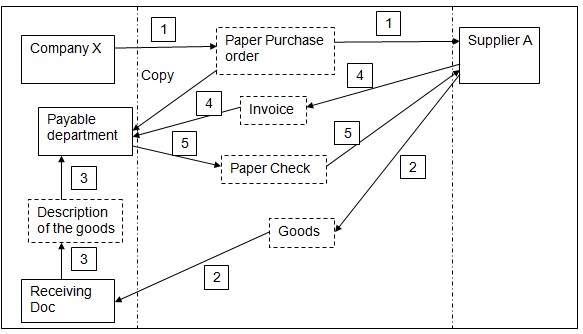
The purchasing department of Company X completes a paper purchase order and sends it to Supplier A via fax, with a copy going to the accounts payable department of X. Supplier A ships the goods and they arrive at X’s receiving dock. A clerk at X’s receiving dock completes a paper form describing the goods and sends it to X’s accounts payable department. Supplier A meanwhile sends an invoice to X’s account payable department. A clerk in X’s accounts payable department would match three documents: the original purchase order, the receiving document, and the invoice. If all three documents match, an accounts payable clerk issues a paper check to supplier A.

The purchasing department of Company X completes a purchase order in an online database and sends the purchase order electronically to Supplier A via an extranet. The online database containing the purchase order is electronically accessible by the accounts payable department via an intranet. Supplier A ships the goods and they arrive at X’s receiving dock. The goods are scanned and identified using RFID. The receiving information is automatically reconciled with the purchase order in the online database. If they match the purchase order, the receiving clerk will acknowledge the acceptance of the goods by pushing a button on a wired or wireless computing device, updating the receiving status online. The electronic acceptance will automatically authorize payment by the accounts payable department, which issues an electronic payment to supplier A. If the matching fails, the receiving clerk refuses shipment and sends the goods back to suppler A.
References
Earl, Michael J., ed. Information Management: The Organizational Dimension. Oxford: Oxford University Press, 1998.
Scammell, Alison, ed. Handbook of Information Management. London: Aslib-IMI, 2001.